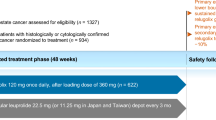Abstract
Histrelin is a gonadotropin-releasing hormone agonist available in a diffusion-controlled reservoir drug delivery system for subcutaneous implantation.
The subcutaneous histrelin implant provided sustained suppression of serum testosterone, luteinizing hormone (LH) and prostate-specific antigen levels for up to 1 year in patients with advanced prostate cancer in two phase II or III trials.
In the noncomparative, multicentre, phase III study, serum testosterone was suppressed to castrate levels (i.e. ≤50 ng/dL) within 4 weeks in all patients who received a histrelin acetate 50 mg implant, with 99–100% of histrelin implant recipients maintaining castrate levels for the remainder of the 1-year treatment period. Such efficacy was provided irrespective of patient age or stage of disease.
Although a transient surge in serum testosterone levels occurred after placement of the initial histrelin implant, no acute elevations in testosterone or LH levels were observed in patients whose implant was replaced after 1 year of therapy and suppression of these hormones continued to be maintained.
The histrelin implant was generally well tolerated in patients with advanced prostate cancer in the phase III trial and in a pooled analysis. No patients prematurely discontinued treatment because of adverse events, most of which were the consequence of hormone suppression.

Similar content being viewed by others
References
American Cancer Society®. Global cancer facts and figures 2007 [online]. Available from URL: http://www.cancer.org/downloads/STT/Global_Facts_and_Figures_2007_rev2.pdf [Accessed 2009 Dec 16]
Jemal A, Siegel R, Ward E, et al. Cancer statistics, 2009. CA Cancer J Clin 2009 Jul–Aug 31; 59(4): 225–49
Thompson I, Thrasher JB, Aus G, et al. Guideline for the management of clinically localized prostate cancer: 2007 update. J Urol 2007 Jun; 177(6): 2106–31
Horwich A, Parker C, Kataja V. Prostate cancer: ESMO clinical recommendations for diagnosis, treatment and follow-up. Ann Oncol 2008 May; 19 Suppl. 2: ii45–6
Loblaw DA, Virgo KS, Nam R, et al. Initial hormonal management of androgen-sensitive metastatic, recurrent, or progressive prostate cancer: 2007 update of an American Society of Clinical Oncology practice guideline. J Clin Oncol 2007 Apr 20; 25(12): 1596–605
National Institute for Health and Clinical Excellence. Prostate cancer: diagnosis and treatment [online]. Available from URL: http://www.nice.org.uk/nicemedia/pdf/CG58FullGuideline.pdf [Accessed 2009 Dec 9]
National Comprehensive Cancer Network®. NCCN clinical practice guidelines in oncology™ prostate cancer, V.2.2009 [online]. Available from URL: http://www.nccn.org [Accessed 2009 Dec 9]
Heidenreich A, Aus G, Bolla M, et al. EAU guidelines on prostate cancer. Eur Urol 2008 Jan; 53(1): 68–80
Kintzel PE, Chase SL, Schultz LM, et al. Increased risk of metabolic syndrome, diabetes mellitus, and cardiovascular disease in men receiving androgen deprivation therapy for prostate cancer. Pharmacotherapy 2008 Dec; 28(12): 1511–22
Freedland SJ, Eastham J, Shore N. Androgen deprivation therapy and estrogen deficiency induced adverse effects in the treatment of prostate cancer. Prostate Cancer Prostatic Dis 2009; 12(4): 333–8
van Poppel H, Nilsson S. Testosterone surge: rationale for gonadotropin-releasing hormone blockers? Urology 2008 Jun; 71(6): 1001–6
Schlegel P. A review of the pharmacokinetic and pharmacological properties of a once-yearly administered histrelin acetate implant in the treatment of prostate cancer. BJU Int 2009 Mar; 103 Suppl. 2: 7–13
Hall MC, Fritzsch RJ, Sagalowsky AI, et al. Prospective determination of the hormonal response after cessation of luteinizing hormone-releasing hormone agonist treatment in patients with prostate cancer. Urology 1999 May; 53(5): 898–903
Oefelein MG. Time to normalization of serum testosterone after 3-month luteinizing hormone-releasing hormone agonist administered in the neoadjuvant setting: implications for dosing schedule and neoadjuvant study consideration. J Urol 1998 Nov; 160(5): 1685–8
Food and Drug Administration. Vantas™ (histrelin implant): US prescribing information [online]. Available from URL: http://www.accessdata.fda.gov/drugsatfda_docs/label/2004/21732lbl.pdf [Accessed 2009 Dec 4]
Orion Pharma (UK) Limited. Vantas 50 mg implant: UK summary of product characteristics [online]. Available from URL: http://emc.medicines.org.uk [Accessed 2009 Dec 4]
Barradell LB, McTavish D. Histrelin: a review of its pharmacological properties and therapeutic role in central precocious puberty. Drugs 1993; 45(4): 570–88
Schlegel PN, Kuzma P, Frick J, et al. Effective long-term androgen suppression in men with prostate cancer using a hydrogel implant with the GnRH agonist histrelin. Urology 2001 Oct; 58(4): 578–82
Schlegel PN. Efficacy and safety of histrelin subdermal implant in patients with advanced prostate cancer. J Urol 2006 Apr; 175(4): 1353–8
Doelle GC, Evans RM, Alexander AN, et al. Single dose responses to the gonadotropin-releasing hormone agonist analogue [(imBz 1)-D-His6,Pro9-NEt]GnRH. Horm Metab Res 1986 Mar; 18(3): 201–2
DeFazio J, Lu JKH, Vale W, et al. Effects of the (imBz1)D-His6, Des-Gly analog of GnRH on gonadotropin and estradiol secretion in normal women. Endocr Res 1984; 10(2): 163–70
Dineen MK, Tierney DS, Kuzma P, et al. An evaluation of the pharmacokinetics and pharmacodynamics of the histrelin implant for the palliative treatment of prostate cancer. J Clin Pharmacol 2005 Nov; 45(11): 1245–9
Chertin B, Spitz IM, Lindenberg T, et al. An implant releasing the gonadotropin hormone-releasing hormone agonist histrelin maintains medical castration for up to 30 months in metastatic prostate cancer. J Urol 2000 Mar; 163(3): 838–44
Fridmans A, Chertin B, Koulikov D, et al. Reversibility of androgen deprivation therapy in patients with prostate cancer. J Urol 2005 Mar; 173(3): 784–9
Acknowledgements and Disclosures
The manuscript was reviewed by: A. Berruti, Medical Oncology, Department of Clinical and Biological Sciences, University of Torino, Torino, Italy; R.B. Nadler, Northwestern University, Chicago, Illinois, USA.
The preparation of this review was not supported by any external funding. During the peer review process, the manufacturer of the agent under review was offered an opportunity to comment on this article. Changes resulting from comments received were made on the basis of scientific and editorial merit.
Author information
Authors and Affiliations
Corresponding author
Rights and permissions
About this article
Cite this article
Deeks, E.D. Histrelin. Drugs 70, 623–630 (2010). https://doi.org/10.2165/11204800-000000000-00000
Published:
Issue Date:
DOI: https://doi.org/10.2165/11204800-000000000-00000




